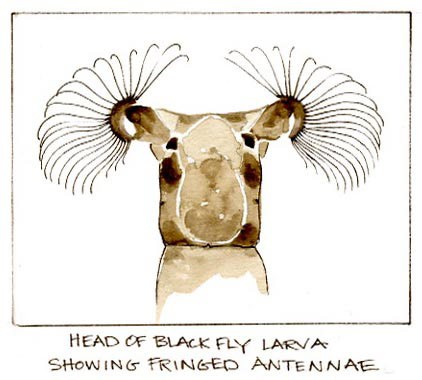
Our brook in February is not yet in flood stage, nor is it in full throat, although now I can hear it from the house.
If I could stir myself sufficiently, I’d approach the brook’s icy edge to see what’s happening. For the best viewing I could use the equipment of warmer months, but right now submerging my face with a mask and snorkel is unthinkable.
A simpler and more comfortable option might be to cut a small window in the ice through which a surprising amount of life activity can be seen even without a mask. Or seek an already ice-free patch.
What is there to see in an icy brook?
Insects for one thing. Even if there are fewer varieties to see in winter, the populations of particular species can be enormous. Grab a quick handful of leafy waterweed (Elodea) or gritty stonewort (Chara) growing on the bottom, swish it in a bowl of tap water, and hundreds of backswimmers and mayfly nymphs will be evicted from their winter refuge.
Depending upon the species, the insects in a winter stream exist as adults, nymphs or larvae—often changing location in the water to avoid detached or shifting ice. A few species, like mountain midges, get through the winter as eggs; others, like crawling water beetles, freeze in ice, only to re-emerge unscathed in spring. To escape crushing ice or late-winter floodwater, mobile insects tend to seek protection in crevices or pools to the side of the stream. They return to their usual habitats when conditions improve.
Active insects must adjust their diet in winter. Instead of browsing on summertime’s sun-loving filamentous green algae, mayfly nymphs in winter turn to scraping algae off rocks, especially single-celled green desmids and a golden-brown algae known as diatoms.
Predatory dragonfly and damselfly nymphs as well as powerful dobsonfly larvae (called hellgrammites) retreat to sheltered spots in crevices, under rocks, or in the quieter waters of sand-strewn eddies. Feeding opportunities are lessened, but these fierce predators remain ready for whatever comes along.
In winter – as in summer—caddisfly larvae hang out in the quieter spots in the stream, providing them security, while their perfectly formed nets, made of silk emitted from salivary glands, catch anything, living or dead, coming downstream. As winter progresses less food is available to be caught in nets, so the larvae turn to suspended diatoms and desmids rasped off rocks by upstream ice. By late winter their nets, worn and torn, finally come apart, and the larvae hunker down and begin their slow metamorphosis into summer’s adult form.
Another brook insect larva, that of the notorious black fly, lives near riffles in the swiftest flow. It unfolds fringed antennae that catch whatever tidbits of plant and animal material come along. If a larva is dislodged from its holding, it returns to its original site by reeling in a silken lifeline.
Like other brook insects passing through complete metamorphosis, a black fly’s pupa remains underwater. Over time, it shortens and thickens to become a streamlined humpbacked knob cemented to its parent rock. Its antennae extend into the current to also provide the oxygen necessary for the insect’s transformation into an adult.
In spring an adult black fly emerges from its underwater pupa and is whirled to the surface in a bubble of air. Soon afterwards, it breaks free and becomes airborne —heading off to seek that tender spot behind your ears.
While there is a surprising constancy in a brook’s insect population throughout the year, winter’s inhospitable conditions help dictate a particular insect species’ stage of growth and how and when it ends an aquatic existence to begin a terrestrial life.
Adaptations for survival in cold, turbulent, highly oxygenated water are so pronounced that if a brook insect is removed and placed in a still aquarium, it will quickly show signs of distress. Even if the aquarium water is well aerated, the water’s oxygen content is a far cry from that of a brook in February. The insects will try to cope but almost always succumb.
I’ve built a couple of big complicated Plexiglas affairs that simulate natural conditions well enough for some mountain brook creatures to live fairly normal lives. It’s not easy, nor always successful, but it does offer a view of their otherwise hidden world. It beats sticking your head through a hole in the ice.

